Utah County Birders Newsletter
|
 |
Contents
June Meeting
Upcoming Field Trips
Captainís Log
Bird of the Month
Field Trip Report
- Hollow Park, Payson
Field Trip
Report - Utah County Hotspots
Backyard Bird of the Month
May Hotline Highlights
JUNE MEETING:
Thursday, June 9th, 2016 -
7pm at the Bean
Museum.
Neil Paprocki from
Hawkwatch will give a presentation titled
"Short-eared Owl Conservation and Citizen Science" on a Citizen
Science project currently under way to understand more about Short-eared Owl
populations in Utah.
Meet at 7:00 pm at the Monte L. Bean Museum. 645 East 1430 North, Provo, UT http://mlbean.byu.edu/
Friday, June 10, 2016: 5 pm til dark. - Genola and Chimney Rock Pass, led by Suzi Holt. We will meet at the Payson Walmart by the big blue sign. From there we will head West to Genola check for the Bobolink, then Elberta looking for burrowing owl, long-billed curlew. Then head out through Chimney Rock Pass. Ending close to Eureka.
Saturday, June 18th, 2016: 7am-12pm - Soldier's Pass on the west side of Utah Lake, led by Keeli Marvel. We will drive over the pass, stopping in various places to listen for birds and see what is around. We may also bird along the west end of Utah Lake on our way back. Higher clearance vehicles recommended for the Soldier's Pass Road. Meet in the southwest corner of the Saratoga Springs Walmart parking lot near the Chase Bank.
We are actively recruiting people to lead local half-day field
trips, any time, any place. If you would like to lead a field trip or if you
have any ideas for this yearís field trips, please contact Keeli at -
keeli.marvel@gmail.com
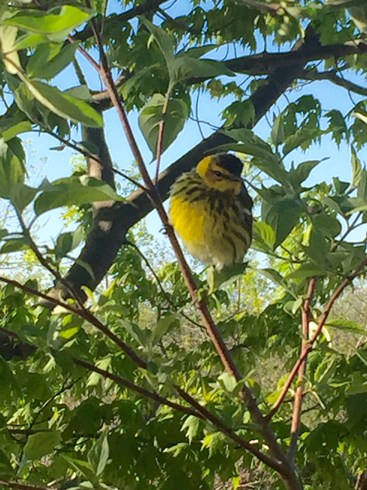 |
|
Cape May Warbler |
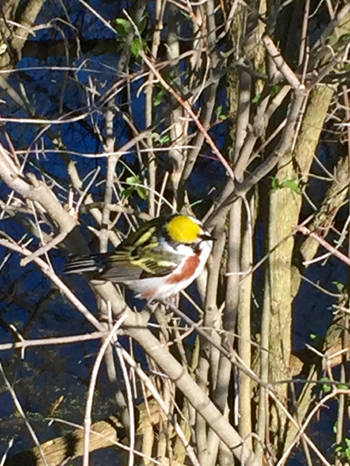 |
|
Chestnut-sided Warbler |
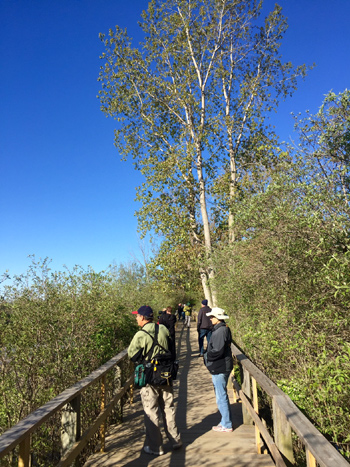 |
|
The boardwalk at Magee when I first got there. It was a beautiful day! |
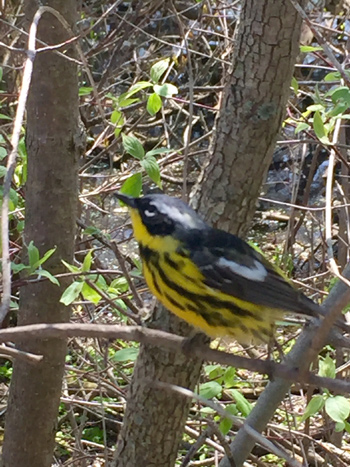 |
|
Magnolia Warbler photo bomb |
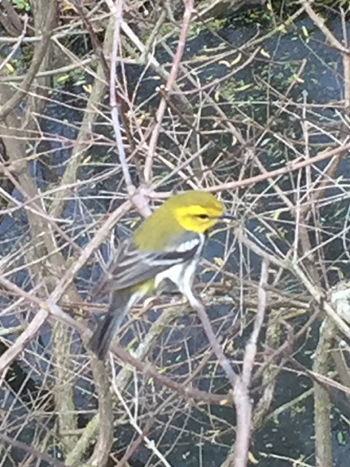 |
|
Black-throated Green Warbler |
Utah County Birders Captainís Log:
June 2016
by Keeli Marvel
I had a 21 warbler day and my mind was blown after five minutes on the boardwalk
at Magee Marsh. But Iím getting ahead of myself.
I was fortunate enough to get work to approve my attendance to a bird banding
training at the Powdermill Nature Reserve/Research Center conducted by the
Carnegie Museum of Natural History in Pennsylvania. I spent five days expanding
my understanding of bird ageing and molt patterns and banding birds that I
hadnít even seen in the field before. During our off time I did a little birding
and picked up a few lifers: Black-throated Green Warbler, Blue-winged Warbler,
Bay-breasted Warbler, Cape May Warbler, Black-throated Blue Warbler, American
Woodcock and Cerulean Warbler, Least Flycatcher, Veery, Louisiana Waterthrush,
Canada Warbler, and Rose-breasted Grosbeak. Most of these birds were seen right
around the banding center, however, one evening I drove up to Linn Run State
Park and picked up the Veery, Canada Warbler, and the Louisiana Waterthrush.
Another evening we drove a few miles away from the research center to a park
called Laurel Highlands State Park, where I picked up the Black-throated Blue
Warblers and walked out to a bog with an impressive display of carnivorous
Pitcher Plants. On our last day at the Research Center, one of the guys doing
his phD research at Powdermill took us out a few miles away from the center to
find the Cerulean Warblers. Lifer! I saw way more warblers than Iíd been
expecting to see at the training. So much so, that I was even considering
skipping the trip up to Magee Marsh in favor of spending a few days relaxing and
exploring Pittsburgh. (Crazy, right?) Iím glad I decided to head up to Magee
anyways.
After my training ended, I took a couple of leave days and headed up to northern
Ohio, on the coast of Lake Erie, and about a 3 hour drive from where I was
training. Iíd booked a cheap motel in Port Clinton, and on the morning of May 16
I headed out to Magee Marsh. The Biggest Week in Birding Festival at the Marsh
had ended the day before, but there were still a ton of birders out on the
boardwalk. As my luck would have it, a cold front had gone through the day
before I got there, blowing in the best birds of the season to that point, and I
saw birds they had not seen during the festival. If youíve never been there, the
only way I can describe it is to tell you to watch The Big Year. Itís just like
in the movie Ė hordes of birders packing the boardwalk and brightly colored
warblers literally dripping off the trees everywhere you looked. The only
difference was no one was yelling out rare species and most people were taking
their time quietly moving along the boardwalk.
There were people there with ginormous lenses and the birds were literally too
close for them to focus on. Within the first five minutes I had seen Cape May,
Tennessee, and Chestnut-sided Warblers within armís reach and at eye level. Mind
blowing! It was like that for the entire day. I picked up lifer Philadelphia
Vireo, Gray-cheeked Thrush, and Blackpoll Warblers (500th life species!) at the
marsh. I spent the entire day birding up and down the boardwalk and got
amazingly close-up looks at 21 different warbler species. It was so impressive I
ran out of superlatives to describe it. I would highly recommend it to anyone
who has the opportunity to get up there. Iím not sure what the crowds were like
during the festival, but I would also recommend doing what I did, and showing up
the day after the festival. Hereís my list of warblers I saw at Magee marsh in
one morning of birding along the mile-long boardwalk:
1. Cape May Warbler
2. Magnolia Warbler
3. Tennessee Warbler
4. Nashville Warbler
5. Yellow Warbler
6. Bay-breasted Warbler
7. Ovenbird Warbler
8. Black-throated Green Warbler
9. Black-throated Blue Warbler
10. Blackpoll Warbler
11. Northern Waterthrush
12. Wilsonís Warbler
13. Canada Warbler
14. Northern Parula
15. Yellow-rumped Warbler
16. Palm Warbler
17. Blackburnian Warbler
18. Common Yellowthroat
19. American Redstart
20. Prothonotary Warbler
21. Black-and-white Warbler
I ended the trip with 15 lifers and hit 500 species on my life list with
Blackpoll Warbler as my 500th species, which I was particularly pleased about.
Blackpoll Warblers are a striking black and white warbler with a black cap and
bright orange legs that donít seem to match the rest of what the bird has going
on. I couldnít ask for a better milestone species.
It seems like itís been a particularly good year for migrants here in Utah. I
hope youíve been out to see a few and maybe hit a few milestones yourself.
Happy Birding!
Keeli Marvel
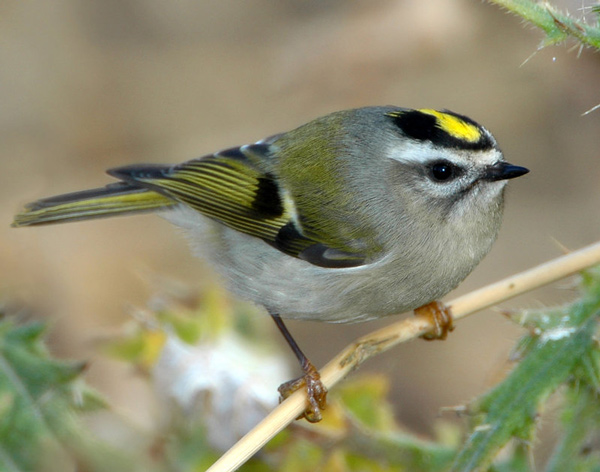 |
|
Golden-crowned
Kinglet
|
Golden-crowned Kinglet
Regulus satrapa
by Machelle Johnson
3.1-4.3 inches, 5.5-7.1 inch wingspan
I've only seen a Golden-crowned Kinglet twice. The first time was in Glacier
National Park, we were hiking to Avalanche Falls. If you haven't been to Glacier
I suggest you drop everything and go now! It is a spectacular, beautiful place.
I saw some activity just off the trail, on the outer tips of a conifer and
stopped to look. The kinglets were hovering at the tips of the branches.
According to Sibley they "glean tiny insects from branches, often hangs
upside-down while foraging or hovers at tips of branches". The other time I saw
them was at Aspen Grove. A few of us went up there hoping to find them and were
lucky enough to see the same activity.
I love to read Pete Dunne's descriptions of birds, he's got a funny sense of
humor. He calls it the 'Conifer Kinglet'. Of the Golden-crowned he says "A tiny,
effervescent, and crisply patterned pixie of a bird. Despite the diminutive
size, (smaller than any warbler), Golden-crowned is overall neckless and plump-
a dumpling with a petite pointy bill, beady black eyes, and a short, narrow,
deeply notched tail. In all plumages, a greenish gray bird with an eye-catching
heavy-mascara face pattern, a racy white-and-yellowish wing pattern, and, in
adults, a golden crown (orange-tinged in males). Sibley says "tiny, even smaller
than Ruby-crowned, with boldly striped face, more gray-green (less buff) overall
color, grayish flanks, bolder wing pattern, and slightly shorter tail". Dunne:
"Hyperactive feeder, hopping quickly between branches and wing-flicking often
(although less than Ruby-crowned). Forages by picking or hovering; is
particularly adept at dangling chickadee-style form the tips of branches."
Dunne says "the song sounds like the laughter of pixies. Begins with several
exceedingly high thin notes that accelerate and degenerate into high squeaky
laughter, just brushing the tympanic membrane." You can listen to it at
allaboutbirds.org.
Golden-crowned kinglets are common and widespread northern and montane breeders
and widespread winter residents. In Utah they occur in the Northern and Eastern
part of the state year round, wintering all over the state. The information I
read didn't specify a typical elevation, but I've only seen them higher up in
the mountains. In winter they can often be found in mixed flocks with
chickadees, creepers, nuthatches and others.
If you would like to write an article for the Bird of the Month, please contact Machelle - machelle13johnson@yahoo.com
Click here for past 'Birds of the Month'.
Field Trip Report
Hollow Park, Payson - May
21st, 2016
by Keeli Marvel
Thirteen people met in the cool drizzle this
morning to bird Hollow Park in Payson. We were pleasantly surprised by the
diversity of species and quality of the bird habitat in this park. For those
unfamiliar with the area, the address of the north end of the park is 400 E 800
S Payson, and the trails run quite a ways through unimproved brushy areas toward
the south. The highlight was a couple of Yellow-breasted Chats calling for most
of our time at the park. Thanks to those who shared local knowledge of the birds
in the area!
Following our walk through the park, most of the group also walked Skipper Bay
where highlights included an overabundance of Bullock's Orioles, Yellow-rumped
Warblers and Western Tanagers, one Eastern Kingbird towards the end of the
trail, and a family of Sandhill Cranes (including a colt!). We looked for the
American Redstart reported earlier, but were not able to relocate it.
Thanks to all who joined us for the field trip!
Happy Birding,
Keeli Marvel
-----------------------
Hollow Park, Utah
25 species
Ring-necked Pheasant 1
Double-crested Cormorant 1
Cooper's Hawk 1
Eurasian Collared-Dove 2
Mourning Dove 1
Black-chinned Hummingbird 1
Broad-tailed Hummingbird 1
Northern Flicker 1
Olive-sided Flycatcher 1
Warbling Vireo 2
Western Scrub-Jay 1
Common Raven 1
American Robin 1
European Starling 4
Yellow Warbler 6
Wilson's Warbler 1
Yellow-breasted Chat 2
Western Tanager 4
Black-headed Grosbeak 1
Lazuli Bunting 5
Bullock's Oriole 1
House Finch 1
Pine Siskin 15
Lesser Goldfinch 4
House Sparrow 1
View this checklist online at http://ebird.org/ebird/view/checklist?subID=S29814121
This report was generated automatically by eBird v3 (http://ebird.org)
------------------------------
Skipper Bay Trail, Utah
37 species (+1 other taxa)
Mallard 5
Cinnamon Teal 1
California Quail 1
Ring-necked Pheasant 2
Snowy Egret 1
Turkey Vulture 3
Osprey 1
Swainson's Hawk 1
Red-tailed Hawk 1
Sandhill Crane 3 Parents with juvenile crane
Killdeer 2
Spotted Sandpiper 1
Mourning Dove 2
Black-chinned Hummingbird 1
Western Kingbird 11
Eastern Kingbird 1
Black-billed Magpie 3
Purple Martin 3
Tree Swallow 3
Violet-green Swallow 20
swallow sp. 100
Black-capped Chickadee 1
Blue-gray Gnatcatcher 1
American Robin 3
MacGillivray's Warbler 1
Yellow Warbler 1
Yellow-rumped Warbler 12
Wilson's Warbler 2
Chipping Sparrow 25
White-crowned Sparrow 2
Lincoln's Sparrow 1 Heard only
Green-tailed Towhee 1
Western Tanager 12 Lots of tanagers migrating through
Red-winged Blackbird 15
Western Meadowlark 2 Heard only
Yellow-headed Blackbird 7
Brown-headed Cowbird 8
Bullock's Oriole 14
View this checklist online at http://ebird.org/ebird/view/checklist?subID=S29818421
This report was generated automatically by eBird v3 (http://ebird.org)
Field Trip
Report
Utah County Hotspots - May
23rd, 2016
by Suzi Holt
Here is the checklist from the Ut Co Hotspots
Fieldtrip. There were 15 UCB and Salt Lake birders that went on this trip.
Utah County, Utah County
74 species (+1 other taxa) total
1 Canada Goose, 2 Gadwall, 3 American Wigeon, 2 Mallard, 4 Cinnamon Teal, 2
Northern Pintail, 2 California Quail, 2 Ring-necked Pheasant, 1 Double-crested
Cormorant, 4 American White Pelican, 5 Great Blue Heron, 1 Snowy Egret, 12
White-faced Ibis, 2 Golden Eagle, 2 Northern Harrier, 3 Swainson's Hawk, 1
Red-tailed Hawk, 4 Sandhill Crane, 5 Black-necked Stilt, 9 American Avocet, 9
Killdeer, 6 Willet, 5 Long-billed Curlew, 2 Ring-billed Gull, 11 California
Gull, 3 Eurasian Collared-Dove, 11 Mourning Dove, 2 Barn Owl, 1 Great Horned
Owl, 2 Black-chinned Hummingbird, 2 Broad-tailed Hummingbird, 2 American
Kestrel, 1 Western Wood-Pewee, 1 Say's Phoebe, 13 Western Kingbird, 1 Eastern
Kingbird, 1 Western Scrub-Jay, 3 Black-billed Magpie, 1 American Crow, 9 Common
Raven, 3 Horned Lark, 1 Northern Rough-winged Swallow, 1 Violet-green Swallow,
13 Barn Swallow, 5 Cliff Swallow, 4 Blue-gray Gnatcatcher, 5 American Robin, 1
Northern Mockingbird, 8 European Starling, 3 Common Yellowthroat, 7 Yellow
Warbler, 4 Yellow-rumped Warbler, 2 Wilson's Warbler, 3 Yellow-breasted Chat, 1
Brewer's Sparrow, 6 Lark Sparrow, 1 White-crowned Sparrow, 1 Song Sparrow, 2
Green-tailed Towhee, 1 Spotted Towhee, 1 sparrow sp., 4 Western Tanager, 3 Blue
Grosbeak, 2 Lazuli Bunting, 9 Red-winged Blackbird, 6 Western Meadowlark, 8
Yellow-headed Blackbird, 1 Brewer's Blackbird, 3 Great-tailed Grackle, 8
Brown-headed Cowbird, 7 Bullock's Oriole, 4 House Finch, 4 Pine Siskin, 1
American Goldfinch, 3 House Sparrow.
Some of us headed over to River Lane to find the Parula, no Parula but we did
get a pretty good list and added 7 to our previous list for a total of 82
species for the day!
River Lane -- Sandy Beach, Utah County
24 species (+1 other taxa) total
1 Red-breasted Merganser, 3 California Quail, 1 Eared Grebe, 3 American White
Pelican, 2 Osprey, 1 Swainson's Hawk, 7 Killdeer, 1 Western Sandpiper, 8
California Gull, 3 Caspian Tern, 4 Mourning Dove, 4 Western Kingbird, 6
Purple Martin, 17 Tree Swallow, 25 Barn Swallow, 15 Cliff Swallow, 100 swallow
sp., 2 American Robin, 8 European Starling, 3 Yellow Warbler, 1 Song Sparrow, 2
Western Tanager, 1 Red-winged Blackbird, 11 Yellow-headed Blackbird, 4 Bullock's
Oriole.
May 2016
Jack Binch - Sandy
I had a female Calliope Hummingbird on 21 May 2016.
Yvonne Carter -
Highland
A male and female Black-headed Grosbeaks have been singing away in the
yard and a first-timer in my yard, a Western Tanager.
Eric Huish - Pleasant Grove
Western Wood-Pewee - calling outside my bedroom window at dawn. Runners-up - Wilson's Warbler, Western Tanager, House Wren, Killdeer, American Crow, Lazuli Bunting, Yellow Warbler. Lots of good yard birds this May.
Keeli Marvel - Saratoga Springs
My backyard bird(S) of the month were two birds I saw last week while window
bird watching from inside my house. I had a Western Tanager and a
Wilson's Warbler show up in the same tree in my backyard right after a
storm.
Milt Moody - Provo
A male Lazuli Bunting showed up a couple of times, but not for very long -- at least one of those beautiful birds finally showed up.
Dennis Shirley - Elk Ridge
Pinyon Jays - May 10,2016 - Had a small noisy flock fly across Loafer
Canyon below house. Only second time ever at yard.
Alton Thygerson - Provo
Band-tailed Pigeons - Two made irregular feeding stops. Probably from the
flock found near MiltĻs home.
Report your favorite backyard bird
each month to Eric Huish at 801-360-8777 or
erichuish@gmail.com
Printable Version of this UCB Newsletter